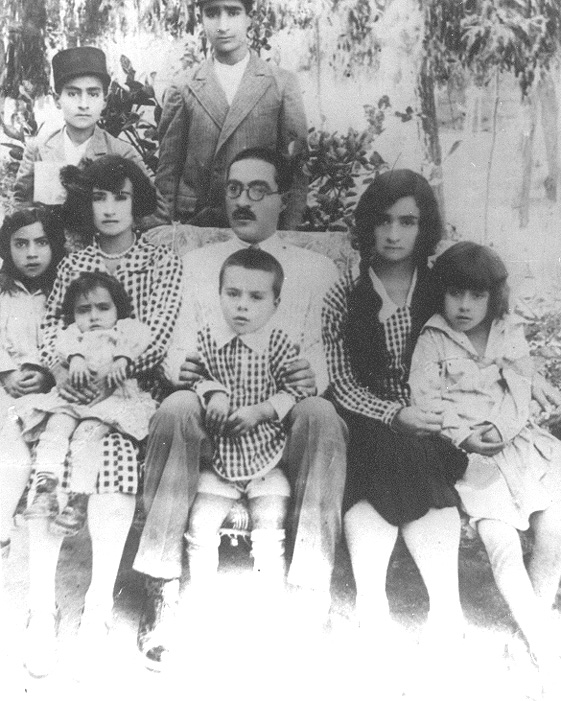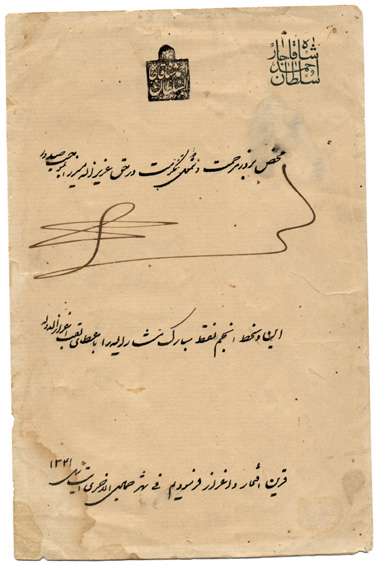
Eskandari-Qajar (Kadjar)
Prince Azizollah Mirza Eskandari, E'zaze-Dowleh, and his family

This is the only extant family picture of my grandfather. It was taken in 1932. He died one year after this picture was taken, poisoned by the agents of Reza Shah who feared him for his loyalty to the Qajars (Kadjars). At the top left corner is my father, Prince Manoutchehr Mirza Eskandari. Next to him standing is his maternal uncle, Hossein Khan, ("Dayeejan Hossein Khan"). Both my father and his uncle are wearing the Farmanfarma cap that was adopted by Reza Shah. On the right hand side of my grandfather (left side of the picture) sits his wife, Zarrin Taj Khanoum, my grandmother. On the left of my grandfather sits his sister-in-law, Shams-ol-Molouk Khanoum ("Khaale Shamsi"). The children, my aunts and uncle, are from left to right, Princess Mahin Taj, Princess Dorrat-o-Taj, Prince Ardeshir, and Princess Farrokh Taj Eskandari.
At the time this picture was taken, my grandfather had been reduced to economic ruin by Reza Shah. He had lost all his possessions in Gorgan, had been sent to Tehran under house arrest to starve to death slowly. Had it not been for his brother, Prince Abbas Mirza Eskandari, and other family members who were helping, the family would have had an even gloomier outlook than it did at that time. Despite the hopeless situation they were in, my grandfather looks as aristocratic as always. He was a handsome, tall, strong man, with piercing eyes, proud to the very last moment of his life of who he was and what he represented. He was a true Qajar (Kadjar) prince.
I, of course, have no independent memory of my grandfather, only the stories I heard from my father and from my father's cousin Prince Iradj Mirza Eskandari. My grandmother never talked about those early memories. They were too painful for her. She was only 30 when she became a widow and had five children to raise. None of the children beside my father really had any recollections of their father, other than the vaguest memories, but my father would relate vignettes here and there of his father's habits, of his erudition and love of mathematics, of his pride in being a Qajar (Kadjar) prince. This particular story stuck in my mind as the one most representing the proud man one sees in this picture.
When Soltan Ahmad Shah went into exile, leaving the country in the hands of Reza Khan, many of the Qajar (Kadjar) princes pledged allegiance to the new government in hopes of getting on with their lives. My grandfather, was one of the exceptions. When he received news of Ahmad Shah's demise and of the coup by Reza Khan, he sent word from his seat in Gorgan that as a Qajar (Kadjar) prince he did not recognize Reza Khan's government as legitimate. Earlier, while Reza Khan was supreme commander of the armed forces, Sardar Sepah, under Ahmad Shah, Reza Khan had visited my grandfather in Gorgan. To receive Reza Khan my grandfather had arranged a sumptuous feast.When Reza Khan arrived his eyes fell on my grandfather's staff and beads, the staff was toped with a large diamond and the beads were of pearls topped with a gold tassel. When my grandfather saw Reza Khan's interest in these items, he offered them to him as a gift, which Reza Khan characteristically accepted without a second thought. But those gifts and the subsequent missive by my grandfather to Reza Khan had marked my grandfather as a person to reckon with and one who would not be swayed. In a sense, they sealed his fate.
My father often mused what would have been if his father had not died so young. It was hard on my father to lose the father he adored at such a young age. My father became head of the household, as the eldest son, at the age of 14. He felt he now had to see to the well-being of the entire household while he himself was still a child. This toughness of character and stiff upper lip that life taught my father early on, became hallmarks of his character throughout his own life. He always felt that everything was an epic struggle in which one was to engage with all one's might, a fight to the death where there could only be one survivor, the victor. Life had not shown itself to be merciful with him. He was going to take it on, head on, and may the best man win.
My grandfather was given the title E'zaze-Dowleh (lit. "Cherished of the government", fig. "dear to the shah"), by Soltan Ahmad Shah, whose distant cousin he was.The document below is the written order, signed by Soltan Ahmad Shah, bestowing that title on my grandfather. This is one of my proudest possessions. This and one or two other items, are the only things that survived years of ravage and repeated exiles by my father and now us. It is almost a miracle that this document found its way to us despite all the vicissitudes our family has gone through.

At the top right hand corner is Soltan Ahmad Shah's letterhead bearing his name. In the top middle is his seal. The brownish swirling mark in the middle is his elegant signature. The text states that because the royal mind feels so disposed, it is the shah's pleasure to bestow the title of E'zaze-Dowleh on Prince Azizollah Mirza.The date is 1341("hejri ghamari,"i.e., 1341 on the Islamic lunar calendar.) It is equivalent to 1921 on the Western, solar calendar. Thus this document was signed by Ahmad Shah in the year his government suffered the coup by Reza Khan. For these reasons this document is most interesting.
My grandfather was the oldest son of son of Prince Ali Khan. He was the older brother of Abbas Mirza, Mohammad Taher Mirza and Princess Shazdeh-Molouk Eskandari, wife of Yahya Mirza Eskandari, my grandfather's cousin as well as brother-in-law. (For more on these personnages, please click here.)